The color of your roof affects more than just the look of your home—it can influence your energy efficiency and comfort. Let’s dive into the science of roof colors to determine which one is best for your climate.
Understanding How Roof Color Affects Heat Absorption
Roof color is a major factor in heat absorption. Dark roofs, such as black, absorb heat, increasing the temperature on the roof’s surface and warming your home. White roofs reflect sunlight, keeping your home cooler and easing the load on your air conditioning.
Climate Considerations: When to Go Light or Dark
The color of your roof should be based on your region’s climate:
- Tropical Climates: In hot climates, white or lighter roofs are ideal for reflecting heat, reducing indoor temperatures, and lowering air conditioning costs.
- Cold Weather Areas: Darker roofs can help absorb sunlight, retaining warmth and reducing heating bills.
- Moderate Climates: A balanced choice might involve neutral or slightly darker shades, depending on your home's insulation.
The Role of Roof Colors in the Urban Heat Island Effect
White roofs can help mitigate the urban heat island effect, a phenomenon where urban areas become significantly warmer due to dark roofs and pavement. By reflecting sunlight, white roofs cool down cities and reduce energy consumption.
Expert Tips from Weathercraft on Selecting Roof Colors
Here are some key factors to consider when choosing your roof color:
- Weather Conditions: Consider your region's typical weather to select the most effective roof color.
- Roof Material Compatibility: Check that your roofing material is compatible with the selected color.
- Home Aesthetic: Consider how the roof color will blend with your home’s exterior for a harmonious appearance.
- Energy Savings: Think about long-term savings in energy costs when selecting a roof color.
At Weathercraft, we guide homeowners in choosing the ideal roof color and material to suit their needs and budgets.
